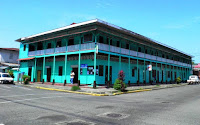 Carnival Limon is an important event in Limon
which has some relevant characteristics such as dance that define the culture of
Limon people; in addiction, it has a history that shows relevant aspects of
Limon.
Carnival Limon is an important event in Limon
which has some relevant characteristics such as dance that define the culture of
Limon people; in addiction, it has a history that shows relevant aspects of
Limon.
Carnival in Limon is known for catch the
attention of everyone, it is a traditions event in Limon where the important
aspect is local dance. This carnival was established in 1949; in addiction, it
is a famous party in Costa Rica´s culture because it commemorates Christopher
Columbus historic arrival in Costa Rica’s Caribbean coast in 1502. The people from
Limon said that idea of this special carnival was created by Alfred Smith and
his friends; moreover, this idea was developed by them while they were having a
conversation at Smith’s barber shop in the downtown of Limon. Likewise, Alfred
Smith and his friend had an objective with this carnival and it was to join
Costa Rica’s culture with the Afro Caribbean’s which in the past had a difficult
relation between them; nowadays, this carnival is considered as one of the most
popular in the country and it means a lot for Costa Rica´s culture. Also, this carnival
is celebrated nowadays to remember that merged between Costa Rica´s culture and
Afro- Caribbean’s culture.
In this event, Costa Rica women, especially African
descent, wear traditional dress and those women move their hips according to
the Caribbean rhythm during the all parades. In this carnival, spectators can see
different types of floats which were made by local people.
In those carnivals the people can enjoy of different
activities that promote the culture of Limon such as to see group of dance, to hear
the magnificent music of troupes which play tropical rhythms as Brazilian samba
and to see people with coloring costumes dancing.
To sum up, this carnival is very special for
the local people because it fosters local culture and it makes emphasis on
dance which is an important element on Limon´s culture.
Name:
Adrían Zumbado Avilés
Date: 29th March 2016
Age: 18 years old
He is from Limon and he studies International
Relations in Universidad Nacional
Questions
- How do Limon people enjoy dance? Explain and give examples
The main activity where the people dance is in carnivals
and in those carnivals you can find variety of dances. There are a lot of place
where you can go and dance for example there are a lot of people who dance
contemporary dance, Calypso or dances with tropical rhythms such as salsa. In every
institution or school from Limon you always will find a Calypso dance group.
- Which aspects do you consider important in activities such as Carnival Limon that promote the local dance?
Some important aspects are that in Carnival Limon you
can see different types of local dances, a variety of coloring costumes and
also flashy floats. Also, there is a lot of artist that use this carnival to
get known and move on. Carnival Limon
promote local culture such as calypso music and local dances.
Resources
Outward Bound. History
of Carnival Limon. Outward Bound Costa Rica. 29 March. Web. n.d.
Isenberg, Robert. Week-long
Carnavales de Limón liven up Caribbean. The Tico Times. 29 March. Web. 14
Oct 2014.













